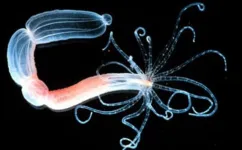(Press-News.org) Of all the mammals, bats have one of the poorest fossil records, with palaeontologists estimating that about 80 per cent of it is missing.
This has made it difficult to pinpoint exactly when they first began to fly, or began roosting in caves, or developed their unique way of ‘seeing’ their surroundings in the dark using sound – called echolocation.
But a near-perfectly preserved bat’s skull discovered by French palaeontologists in a cave that dates back about 50 million years has shed new light on what we thought we knew about this ancient, hypothetical creature.
Emeritus Professor Sue Hand from UNSW Sydney’s School of Biological Earth and Environmental Sciences is a leading palaeontologist with expertise in bat evolution. She led an analysis of the skull, published today in the journal Current Biology, that involved Dr Jacob Maugoust and Professor Maeva Orliac from University of Montpellier in France, and Professor Robin Beck from the University of Salford, UK.
Prof. Hand says prior to the discovery of this skull – which was among 23 separate fossilised individuals found in the cave belonging to the extinct species Vielasia sigei – only fragments or completely flattened skeletons of early bats had existed in the fossil record.
“We don’t know very much about the beginnings of bats because we don’t have the missing links like we do, say, between dinosaurs and modern birds,” she says.
“The oldest bat fossil is about 57 million years old, and it's a single tooth from a site in Portugal – that's all we know about it. The first bats are all just known from fragmentary fossils, mostly teeth. When bats appear in the fossil record a little later, about 52 million years ago, some are wonderfully complete bats, but they’re flattened.”
While these flattened specimens are, in Prof. Hand’s words, “beautifully preserved”, the fact that they’ve been flattened by layers of rock deposited over millions of years makes it difficult to decide with conviction, the exact positioning of bones in their three-dimensional anatomy. And when it comes to determining whether a fossil is from a species of bat that is already using echolocation, detailed and precise anatomy of the skull is crucial.
“In modern bats, between the voice box and the ear, there are some bones called the hyoid bones. In all modern bats that echolocate, one of these bones directly contacts the middle ear bones and appears to be involved in transmitting high frequency sound.
“But in the flattened fossils, while we can see these various bones, there is a question about their precise relationships to each other. This has led to a lot of debate among scientists about whether or not a species used echolocation.”
Uncrushed skull
But in the case of Vielasia sigei, not only is the skull almost entirely intact, but it has been preserved in limestone in its original three-dimensional shape which the scientists describe as ‘uncrushed’.
“In this particular bat, we can see more directly what's going on deeper, in the inner ear,” Prof. Hand says.
“We took fine measurements of that inner ear bone and compared it with that in the bats that do echolocate today and bats that don’t, and it sits in the middle of the ones that echolocate.”
Not all bats echolocate, Prof. Hand explains. Flying foxes regularly seen in the Sydney night sky around the Botanical Gardens, Centennial Park and the Royal National Park rely on their very good eyesight to navigate and find fruit, without echolocation. Meanwhile, Sydney microbats such as the Eastern Bentwing Bat, Gould’s Wattled Bat and the Chocolate Wattled Bat, are well known for navigating and catching insects using feedback from the high frequency sound they emit.
While Prof. Hand stops short of concluding that Vielasia sigei used echolocation with 100 per cent certainty, she says the new evidence is compelling.
“It’s very convincing that the type of echolocation some of these early bats used was indistinguishable from what many echolocating bats use today, and at 50 million years ago, this is well ahead of whales developing this ability.
“Prior to this find, we were only really certain that echolocation developed in the modern families of bats.”
Back to the bat cave
In all, there were 400 fossil bones and teeth discovered by the French team in the cave in south-western France, which represented 23 individuals. Vielasia – which is not a direct ancestor of today’s bats but may have been closely related to it – was only a small bat, with the uncrushed skull measuring only 1.8 cm long.
“There were 23 of these wonderful little bats living in a cave, which also makes it the oldest cave-dwelling bat in the world that we know of,” says Prof. Hand.
“We didn't think that these early bats actually lived in caves. The information had been that they lived in trees around lakes and in forests which stretched right up to both poles because the Earth was very warm at this time.”
But when these greenhouse conditions started to deteriorate later in the early Eocene period – around 50 million years ago and about the same time that this bat was living – there were much more wildly fluctuating changes in temperature.
“So it could be that this bat lived in a cave because this is much more stable environment.”
Inspiration
Whether or not the analysis of the uncrushed Vielasia skull has settled the echolocation debate about early bats, Prof. Hand hopes that it will inspire further exploration of the fossil record.
“We think some of the characteristics of this bat would have also characterised the last common ancestor for modern bats. So it's exciting, and it is actually going to be an important specimen that people will get a lot of information from and use in their own analyses.”
END
Holy bat skull! Fossil adds vital piece to bat evolution puzzle
2023-10-19
ELSE PRESS RELEASES FROM THIS DATE:
Rebates can offer solutions to California’s groundwater woes
2023-10-19
Many aquifers in California and around the world are being drained of their groundwater because of the combined impacts of excess pumping, shifts in land use, and climate change. However, a new study by scientists at UC Santa Cruz and UC Berkeley, published on Oct. 18 in Nature Water, may offer a solution. It describes the development and operation of a novel incentive program that uses water rebates to pay for some of the costs of getting stormwater runoff into the ground. The program is called recharge net metering (ReNeM).
Although ...
Study finds men's antidepressant use did not negatively impact IVF success
2023-10-19
In vitro fertilization (IVF) is a time-intensive and often stress-inducing fertility procedure. Yet how does that stress impact its success? Investigators at Brigham and Women’s Hospital, a founding member of the Mass General Brigham healthcare system, assessed the effects of anxiety and depression in men on fertility and IVF outcomes. Their findings reveal no correlation between anxiety, regardless of antidepressant use, on IVF outcomes or live birth rate. Results are published in Human Reproduction.
“Our findings indicate that despite past concerns over antidepressant medication’s ...
Regular health checkups may prevent the development of end-stage kidney disease (ESKD)
2023-10-19
Niigata, Japan - A new Japanese ecological study revealed that prefecture-specific participation rates for Specific Health Checkups (SHC participation rates) had significant negative effects on prefecture-specific standardized incidence rates (SIRs) of treated ESKD and prefecture-specific prevalence of chronic kidney disease (CKD). The findings support the importance of increasing SHC participation rates at the population level and encouraging people to undergo regular health checkups.
"Japan has one of the highest incidence and ...
Eyes may be the window to your soul, but the tongue mirrors your health
2023-10-19
A 2000-year-old practice by Chinese herbalists – examining the human tongue for signs of disease – is now being embraced by computer scientists using machine learning and artificial intelligence.
Tongue diagnostic systems are fast gaining traction due to an increase in remote health monitoring worldwide, and a study by Iraqi and Australian researchers provides more evidence of the increasing accuracy of this technology to detect disease.
Engineers from Middle Technical University (MTU) in Baghdad and the University of South Australia (UniSA) used a USB web camera and computer to capture tongue ...
CHIPS and Science Act spurs NanoFab cleanroom ribbon cutting at NYU Tandon School of Engineering
2023-10-19
NYU leadership - including recently inaugurated President Linda Mills and NYU Tandon School of Engineering Dean Jelena Kovačević - joined University faculty and partners on October 18th to cut the ribbon at the newly-minted NYU Nanofabrication (NanoFab) Cleanroom, a specialized research environment in which scientists and engineers can fabricate cutting-edge semiconductor chips to advance research on quantum science and engineering, precision medicine, neurotechnologies, next-generation communications technology and secure computing.
Located on NYU Tandon’s ...
New study sheds light on long term effectiveness and safety of two widely used statins
2023-10-19
Two widely used statins, rosuvastatin and atorvastatin, are equally effective at preventing heart attacks, strokes and death in people with coronary artery disease. But while rosuvastatin treatment is associated with lower cholesterol levels, it also carries a higher risk of developing type 2 diabetes than atorvastatin, finds a study published by The BMJ today.
Lowering “bad” (LDL) cholesterol levels with statins is recommended for people with coronary artery disease - a condition where the blood vessels supplying the heart are ...
Surgery more effective than nasal sprays for symptoms of a crooked septum
2023-10-19
Surgery to straighten a crooked septum (the thin wall of bone and cartilage dividing the space between the two nostrils) is more effective than nasal sprays, and should be offered to adults with at least moderate symptoms such as breathing disruption, suggests a UK trial published by The BMJ today.
A crooked (deviated) septum often means that one nasal passage is narrower than the other, making it feel blocked, which can affect breathing, sleep or exercising.
Surgery to correct this (septoplasty) is a common operation. In 2019-20, 16,700 septoplasties were carried ...
Biodegradable plastics still damaging to fish – Otago study
2023-10-19
Biodegradable plastics may not be the solution to plastic pollution many hoped for, with a University of Otago study showing they are still harmful to fish.
Petroleum-derived microplastics are known to impact marine life, but little is known about the impact of biodegradable alternatives.
The study, published in Science of the Total Environment and funded by a University of Otago Research Grant, is the first to assess the impact petroleum-derived plastic and biodegradable plastic have on wild fish.
Lead author Ashleigh Hawke, who completed a Master of Science in Otago’s Department of Marine Science, ...
Groundbreaking journal AI in Precision Oncology publishes preview content
2023-10-19
The fusion of artificial intelligence (AI)-enabled technologies and precision oncology is advancing at an unprecedented pace, and the introduction of the new peer-reviewed journal, AI in Precision Oncology, will support clinicians, researchers, AI experts, patients, and industry leaders with up-to-date advancements in the field while fostering an environment conducive to further innovation and collaboration. A preview issue of the journal is now available. Click here to read the issue now.
“At the heart of my vision for this journal is the ...
US Air Force funds multi-university initiative to study hybrid control, $1.5M annually
2023-10-18
The U.S. Air Force Office of Scientific Research has funded a new Multi-University Research Initiative to be led by Yuliy Baryshnikov, a professor of mathematics and electrical & computer engineering at the University of Illinois Urbana-Champaign. The initiative, Hybrid Dynamics – Deconstruction and Aggregation, or HyDDRA, will bring researchers from four universities together to address the problem of hybrid control using modern mathematical tools.
The initiative will be funded with an award ...



